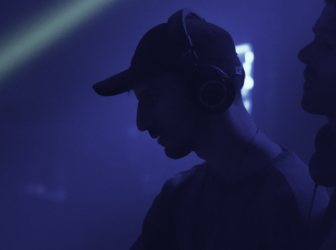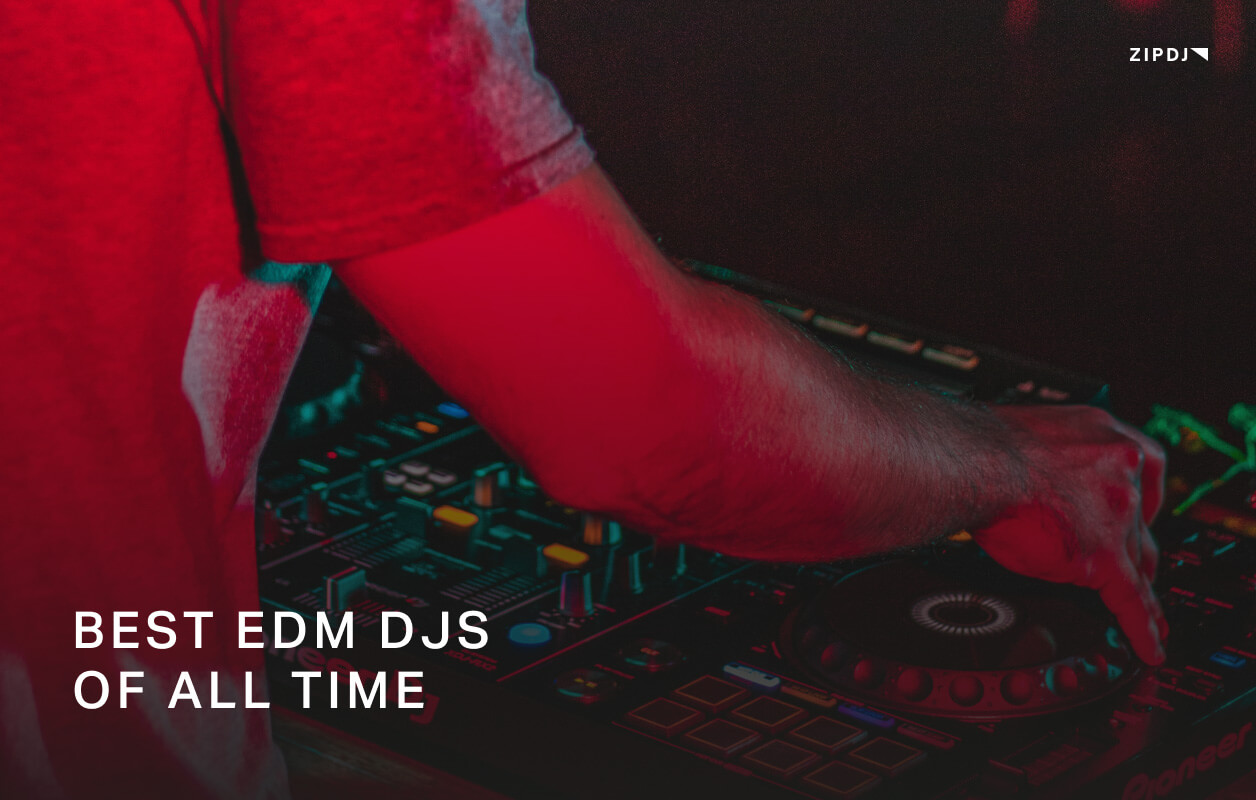DJing Clubs: How To DJ Nightclubs In 2023

For many DJs, landing a prime time slot in their favorite nightclub is the ultimate goal, signaling the beginning of a promising career as a professional.
With a large amount of competition for a limited number of gigs, building and promoting a strong DJ brand is essential if you want to stand out.
Continue reading, and we’ll break down how to start DJing clubs and build a unique brand and style that attracts the best club owners and promoters.
DJing Clubs: How To DJ Clubs In 2023 (Step-By-Step)
For most DJs, performing in a club is the ultimate goal, offering the chance to showcase your musical taste and mixing skills.
It’s also an opportunity to use an impressive sound system, top-flight mixers, and other gear that most casual DJs can’t afford.
Whether you’ve lined up your first warm-up slot or have a headline gig in the pipeline, there are several important things to consider when DJing in clubs.
This step-by-step guide will take you through everything you need to know, but before we begin, let’s take a quick look at what a club DJ does.
What Does A Club DJ Do?
Club DJs bring a range of skills to the table, whether performing in one of the best nightclubs in the world or keeping clientele entertained in a local bar.
They typically use industry-standard gear to play dance music and other upbeat genres to get people dancing through the night.
A great DJ has a solid grasp of all the latest music and understands how to read the dance floor when performing in a packed club.
Resident DJs also work closely with club owners to arrange DJ gigs for specific events, coordinating with other DJs to host a diverse club night.
DJ Equipment You’ll Need
Most clubs have already kitted out the venue’s DJ booth with the necessary DJ equipment for you to use in your first club gig.
This will include the relevant DJ controllers and CDJs for playing music, the entire sound system, and any lights and smoke machines.
However, there are still a few essential items of gear you’ll need to pack before you get started, including headphones and a jack adapter to ensure they work with the mixer.
If you’re using digital download music files for your DJ set, you’ll also need to take a USB stick with all the tracks you plan on using for your DJ mixes.
Now that we’ve covered all the gear you’ll need, let’s begin this step-by-step guide to DJing clubs.
Step 1: Compile Your Music Library
Whether you’re DJing at house parties or birthday parties or starting a new gig as a resident DJ at a local venue, you need an impressive music collection to play with.
Club DJs acquire tracks from various sources, from online music stores such as Apple Music and Beatport to physical vinyl at record stores.
An increasingly popular source of music for DJs is record pools which offer an extensive archive of the latest tracks produced by some of the leading artists.
When DJs sign up to ZIPDJs pool, they get access to thousands of electronic music tracks they can use to help launch their DJ careers.
With unlimited downloads and a constant stream of exclusive uploads, record pools are an excellent way for new DJs with limited collections to build a massive music library.
Step 2: Create A DJ Website
Creating an online presence is the next important step for new DJs who want to break into the club scene.
A DJ website is the first thing a club owner will check out before considering whether or not to book you for your first gig, so it needs to be polished and professional.
Before setting up a website, research some of the best DJ websites from established DJs to see how they lay out their content and what material they include.
This is your chance to impress club owners with your previous DJ mixes and share photos and videos that showcase your DJ style.
Step 3: Set Up Social Media Accounts
Setting up dedicated social media pages on Facebook, Instagram, TikTok, and elsewhere helps significantly broaden the reach of new DJs among potential fans.
Avoid using your existing personal account for your DJ career; a dedicated page is crucial if you want to be taken seriously as a professional.
Use the logos and branding you’ve opted for on your official website, and link all these pages together.
Try to post something at least twice a week, whether this is a link to a new mix you’ve uploaded to SoundCloud or a heads-up on your next live set.
Step 4: Upload Your DJ Sets Online
There are several popular online platforms where DJs can upload their previous sets, which can be a great way to showcase your knack for playing the hottest songs.
Before you begin sharing your content on websites such as SoundCloud, check out a selection of other DJs’ track selections to see what gets the best response.
Researching some of the best DJ sets of all time is a great way to hear the mixes proper nightclubs expect from their DJs.
Engage with any feedback you get from listeners, and make sure you link to your most popular DJ sets when reaching out to a club owner for your first gig.
Step 5: Check Out The Venue & Lineup
Preparing for DJing in a nightclub also requires researching the venue so you know what DJ controller and other equipment they include.
It’s also an excellent opportunity to meet the club’s promoter and build a relationship with the bar staff, clarifying the time slot and other details about your gig.
If you’re on a lineup for an evening, you should head online to see what the other DJs’ style is like and plan a set that will deliver a consistent dance floor experience.
You can also speak with club managers to help you play tracks that transition smoothly from the previous set with the right energy levels.
Step 6: Plan & Practice Your Set In Advance
As the old saying goes, “Practice makes perfect,” and this applies to aspiring club DJs as much as it does any other creative endeavor.
While mobile DJs and other casual DJs can get away with mixing using some basic DJ transitions, the standards for a club DJ are typically higher.
Plan out your set in advance so you have a clear idea of the order you want to play your music, then practice running through and recording the set in its entirety.
If you’re showing off more advanced techniques, such as scratching, make sure you’re completely confident in your abilities to avoid embarrassment on the night of the gig.
Step 7: Promote Your Gig Online & Offline
Once you’ve got the green light for your first night as a club DJ, it’s time to generate some online buzz and anticipation to avoid playing in an empty room.
You can promote your music and build interest in your event in many ways, both online and in the real world.
Some social media platforms, such as Facebook, allow you to pay for targeted ad campaigns in your local area, which is worth considering if you have a moderate budget.
You can also promote your event through online word of mouth, sharing the upcoming event with other local DJs and influencers who appreciate your style.
Traditional promotion methods, such as passing out fliers at other clubs and around the venue, can also help you build interest in the event and draw in a crowd.
Step 8: Begin With An Opening Set
If you’re new to DJing in a club, jumping straight in with a headlining slot is unlikely, so aim to start your DJ career with an opening set.
While you’ll likely start with a smaller crowd, this can be an excellent way to build confidence and familiarize yourself with the venue’s setup.
An opening set should set the pace for the rest of the evening, so avoid playing tracks with too much energy; instead, build up the energy gradually to segue into the next DJ.
Step 9: Learn How To Read The Crowd
Many of the highest-paid DJs have achieved fame and fortune due to their ability to read the crowd and play the best tracks for the moment.
If you’re new to DJing, there’s no shortcut to getting this right; reading the crowd well comes through experience.
The more gigs you play, the better you’ll be able to gauge how the DJ’s music is working for the crowd, making it easier to adapt a set accordingly.
Once you’ve got into the swing of reading a crowd, you’ll be able to perform mixes that don’t stick closely to a defined playlist with more freedom to experiment.
Step 10: Network During The Event
Last but not least, when you finally land your ideal club gig, you should embrace it as an opportunity to network with potential fans and event promoters.
Striking up a conversation with the bar owner and the venue’s customers can lead to more work as a DJ in the future.
Whether this leads to additional club gigs or getting a spot at a private party, the importance of networking shouldn’t be overlooked.
Try to bring the same energy and enthusiasm to your interactions with the people you meet at the gig as you do for the set itself and make it a part of your brand.
How To Get Your First Club DJ Gig
If you’d like to check out a quick overview of the best ways to get your first club gig but don’t have time to read the full article, we’ve got you covered.
Here’s a more concise step-by-step guide to help you get started and launch a successful career as a DJ:
- Ensure you have a strong online presence by combining an attractive website with a selection of social media channels.
- Share previous DJ sets and gig photos to help establish an identifiable style and brand.
- Research the local venues you hope to get your first gig so you know what the venue owners are looking for.
- Practice the first set you hope to play until you know all the tracks and DJ transitions by heart.
- Communicate and engage with fans and event promoters regularly to generate as much interest as possible in your upcoming club night.
If you put together a checklist of things to do before applying for a role as a club DJ, you’ll be well on your way to performing your first gig.
Mistakes To Avoid As A Club DJ
We’ve covered many important things you need to do to become a successful club DJ and stand out from the competition.
To leave a positive and lasting impression, here are some mistakes you need to avoid:
- An overemphasis on only playing the latest songs without mixing things up with recurrent music and popular classic tracks.
- Overhyping the event on social media and in real life and saturating your pages with too much content filling up your followers’ timelines.
- Failing to read the crowd properly and playing inappropriate tracks for the time slot you’re DJing in.
- A lack of familiarity with industry-standard DJing equipment leads to silly mixing mistakes that make you look inexperienced.
- Getting taken advantage of by club owners and promoters by not clearly outlining your fees and the value you bring to the table.
If you make some mistakes when working on your club DJ career, take them as an opportunity to learn and grow, avoiding them in the future.
Summary
We hope you’ve found this step-by-step guide to DJing in clubs helpful, with plenty of pointers to set you on track for a career as a DJ.
As with many creative pursuits, reviewing your approach and learning from experience is important so you can fine-tune your strategy over time.
While there’s a lot of competition for DJing gigs in nightclubs, success will soon follow if you bring something new and innovative to the table.
Build a comprehensive library of exclusive and unreleased music by signing up to ZIPDJ, ensuring you stand out at your first club gig.
Not a member ?
Join Today for Unlimited Music Downloads. Visit zipdj.com for more information.



